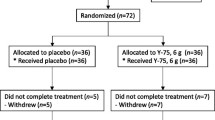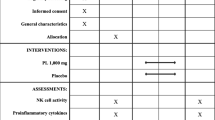Abstract
This study was designed to determine the possible effects of omeprazole on human natural killer cells. Peripheral venous blood samples were taken from 20 peptic ulcer patients before and at the 14th and the 28th days of omeprazole treatment. Mononuclear cells were removed from blood and their capability of making conjugation with K562 target cells and lysing K562 target cells was evaluated. A significant decrease was found (P < 0.001) in the 14th and the 28th days compared with the basal value of the capability of the mononuclear cells to conjugate with the K562 target cells and to lyse them. This study demonstrated that omeprazole significantly reduces natural killer cell functions. This finding suggests that omeprazole may also have some effects on the other systems in addition to parietal cell acid secretion.
Similar content being viewed by others
References
Clissold SP, Campoli-Richards DM (1986) Omeprazole: a preliminary review of its pharmacodynamic and pharmacokinetic properties and therapeutic potential in peptic ulcer disease and Zollinger-Ellison Syndrome. Drugs 32:15–47
Fellenius E, Berglindh T, Sachs G, Olbe L, Elander B, Sjostrand SE, Wallmark B (1981) Substituted benzimidazoles inhibit gastric acid secretion by blocking (H+–K+) ATPase. Nature 290:159–161
Fryklund I, Gedda K, Wallmark B (1988) Specific labelling of gastric H+, K+ ATPase by omeprazole. Biochem Pharmacol 37:2543–2549
Keeling DJ, Fallowfield C, Underwood AH (1987) The specificity of omeprazole as an (H+–K+)-ATPase inhibitor depends upon the means of its activation. Biochem Pharmacol 36:339–344
Sachs G, Wallmark B (1989) The gastric H+,K+-ATPase: the site of action of omeprazole. Scand J Gastroenterol 24(Suppl 166):3–11
Amzel LM, Pedersen PL (1983) Proton ATPases: structure and mechanism. Ann Rev Biochem 52:801–824
Anderson RGW, Orci L (1988) A view of acidic intracellular compartments. J Cell Biol 106:539–545
Mellman I, Fuchs R, Helenius A (1986) Acidification of the endocytic and exocytic pathways. Ann Rev Biochem 55:663–700
Wandall JH (1992) Effects of omeprazole on neutrophil chemotaxis, super oxide production, degranulation and translocation of cytochrome b-245. Gut 33:617–621
Aybay C, Imir T, Okur H (1995) The effect of omeprazole on human natural killer cell activity. Gen Pharmacol 26:1413–1418
Timonen T, Ortaldo JR, Herberman RB (1981) Characteristics of human large granular lymphocytes and relationship to natural killer and K cells. J Exp Med 153:569–582
Imir T, Sibbitt W, Bankhurst A (1987) The relative resistance of lymphokine activated killer cells to suppression by prostaglandins and glucocorticoids. Prostaglandins Leukotriens Med 28:111–118
Bankhurst AD, Imir T (1989) The mechanism involved in the activation of human natural killer cells by Staphylococcal Enterotoxin B. Cell Immunol 122:108–121
Ullberg M, Jondal M (1981) Recycling and target binding capacity of human natural killer cells. J Exp Med 153:615–628
Scaringi L, Cornacchione P, Fettucciari K, Rosati E, Rossi R, Marconi P, Capadicosa E (1996) Activity inhibition of cytolytic lymphocytes by omeprazole. Scand J Immunol 44:204–214
Capodicasa E, De Bellis F, Pelli MA (1999) Effect of lansoprazole on human leukocyte function. Immunopharmacol Immunotoxicol 21:357–377
Shamburek RD, Ruddy S, Schubert ML (1993) Omeprazole and neutrophil function. Gastroenterology 104:938–940
Mc Tavish D, Buckley MM-T, Heel RC (1991) Omeprazole, an updated review of its pharmacology and therapeutic use in acid-related disorders. Drugs 42:138–170
Lindberg P, Nordberg P, Alminger T, Brandstrom A, Wallmark B (1986) The mechanism of action of the gastric acid secretion inhibitor omeprazole. J Med Chem 29:1327–1329
Verhoef J, Sharma SD (1983) Inhibition of human natural killer activity by lysosomotropic agents. J Immunol 131:125–131
De Duwe C (1983) Lysosomes revisited. Eur J Biochem 137:391–397
Deem RL, Targan SR (1984) Evidence of a dynamic role of the target cell membrane during the early stages of the Natural Killer cell lethal hit. J Immunol 133:72–77
Suzuki M, Mori M, Miura S, Suematsu M, Fukumura D, Kimura H, Ishii H (1996) Omeprazole attenuates oxygen-derived free radical production from human neutrophils. Free Radic Biol Med 21:727–731
Suzuki M, Nakamura M, Mori M, Miura S, Tsuchiya M, Ishii H (1995) Lansoprazole inhibits oxygen-derived free radical production from neutrophils activated by Helicobacter pylori. J Clin Gastroenterol 20(Suppl 2):S93–S96
Suzuki M, Mori M, Fukumura D, Suzuki H, Miura S, Ishii H (1999) Omeprazole attenuates neutrophil-endothelial cell adhesive interaction induced by extracts of Helicobacter pylori. J Gastroenterol Hepatol 14:27–31
Suzuki H, Miyazawa M, Nagahashi S, Sato M, Bessho M, Nagata H, Miura S, Ishii H (2003) Rabeprazole treatment attenuated Helicobacter pylori-associated gastric mucosal lesion formation in Mongolian gerbils. J Gastroenterol Hepatol 18:787–795
Yoshida N, Yoshikawa T, Tanaka Y, Fujita N, Kassai K, Naito Y, Kondo M (2000) A new mechanism for anti-inflammatory actions of proton pump inhibitors – inhibitory effects on neutrophil-endothelial cell interactions. Aliment Pharmacol Ther 14(Suppl 1):74–81
Valori RM, Cockal R (1990) Omeprazole for duodenal ulceration in Crohn’s Disease. Br Med J 300:438–439
Author information
Authors and Affiliations
Corresponding author
Rights and permissions
About this article
Cite this article
Alkim, H., Unal, S., Okur, H. et al. Omeprazole Inhibits Natural Killer Cell Functions. Dig Dis Sci 53, 347–351 (2008). https://doi.org/10.1007/s10620-007-9869-2
Received:
Accepted:
Published:
Issue Date:
DOI: https://doi.org/10.1007/s10620-007-9869-2




